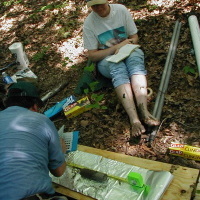Books by Alexander Doweld

The genus Sphenaster was erected by Jeffery (in Smith et al. 1999: 131) for a distinctive fossil ... more The genus Sphenaster was erected by Jeffery (in Smith et al. 1999: 131) for a distinctive fossil echinoid of the Thanetian (Palaeocene) age from Spain and considered to be the most ancient element of the echinoid family AEROPSIDAE Clark, 1917 (Spatangida, Echinoidea). Unfortunately, up to now (Kroh 2010), it was not realized that the generic name Sphenaster is invalid, being a junior homonym of Sphenaster Wilcoxon, 1970: 80, a genus of fossil protist (HAPTOMONADA).
As the protistan generic name Sphenaster Wilcoxon, 1970 is nomenclaturally available in zoology and still recognized in modern protistology and palaeoalgology (as a member of the HAPTOMONADA), a new generic name is necessary for the fossil echinoidean genus. To resolve this homonymy, in accordance with the International Code of Zoological Nomenclature (‘the Code’ below), a new replacement name is here proposed for Sphenaster Jeffery, 1999 nec Wilcoxon, 1970.
The genus Disparella (D. fusiformis Fedorov, 1987, by original designation) was established in Fe... more The genus Disparella (D. fusiformis Fedorov, 1987, by original designation) was established in Fedorov and Pereladov [1] for distinctive fossil spiculae of sponges from NorthEastern Siberia of Cambrian age. However, Hessler [2] , a living isopod (Crustacea: Malacostraca: Isopoda: Asellota: Desmosomatidae), preceded fossil generic name, which becomes a preoccupied later homonym.

Recently it was found (Doweld 2016) that the generic name Aenigma Kuznetsova (1957: 68; type spec... more Recently it was found (Doweld 2016) that the generic name Aenigma Kuznetsova (1957: 68; type species A. jucunda Kuznetsova, by original designation) of fossil Ostracoda from the Lower Cretaceous (Barremian) of Tegchaj, North-Eastern Azerbaijan, former USSR (Transcaucasia), is already preoccupied by a marine gastropod molluscan generic name Aenigma Newman (1836: 499), which is in active current use in zoology (Coleoptera: Carabidae), along with a few
other known homonyms, Aenigma Amsel (1956: 288) [Lepidoptera], Aenigma Koch (in Martini & Chemnitz 1846: 1, unpaginated) [Mollusca], Aenigma Karsch (1878: 825) [Arachnida], Aenigma Strecker (1876: 122) [Lepidoptera]. Therefore, a new replacement name was proposed, Kuznetsovia Doweld (2016: 68). However, it was overlooked that this
generic name is already preoccupied by Kuznetsovia Kammerer (2006: 269) [Arthropoda], escaped from Nomenclator Zoologicus and Zoobank. In this connection, to resolve unexpected homonymy with an arthropod generic name, in accordance with article 60 of the International Code of Zoological Nomenclature (1999), a new replacement name is proposed for the fossil Ostracoda genus.

The book contains an outline of the phylogenetic system of Vascular plants (Tracheophyta) in the ... more The book contains an outline of the phylogenetic system of Vascular plants (Tracheophyta) in the form of Syllabus of all validly published from 1753 family, (super-, sub-) ordinal, (sub)class, and (sub)phylum names, including for the first time revised and summarized fossil suprageneric names. The Prosyllabus covers all vascular plants, including fossil, for the period of cca. 420 mln years (Upper Silurian-Extant). The Prosyllabus Tracheophytorum is published in the anticipation of the issuance in 2003 of New Syllabus of Plant Families (A Plant World System) [in English], which has been initiated by German botanist Adolf Engler in 1892 (as Syllabus der Pflanzenfamilien) and served as a main source of systematic botany for the nearly half of XX century.22 phyla of vascular plants (including extinct forms) contain 2857 validly published names of families, orders, superorders, (sub-)classes as on December, 2001. Descriptive, illegitimate and invalidly published suprageneric names were omitted. An accepted system summarized molecular phylogenetics, carpology and seed anatomy in particular, for the system of flowering plants, ferns, club-mosses, conifers, cycads and fossil vascular plants.A revised detailed system of Eukaryota is also added with 481 analogous suprageneric names: the Eukaryota is considered as a domain (empire) of organisms, splitted into two subdomains, Chlorota (plant-like organisms aggregated into 5 kingdoms, Euglenobiota, Peridiniobiota, Bacillariobiota, Rhodymeniobiota, Chlorobiota) and Zoota (animals and fungi in 6 kingdoms, viz. Amoebobiota, Mucorobiota, Trichoplacobiota, Spongiobiota, Hydrobiota, Zoobiota). 504 new suprageneric names (from family to botanical kingdoms) are validated according to provisions of both International Codes of Botanical and Zoological Nomenclature; Protozoa were abandoned as polyphyletic taxon and replaced with numerous new phyla, subregnums and regnums. A comprehensive bibliography (671 entries) covers all papers and books in which where validly published all summarized suprageneric names for the period of cca. 250 years (since 1753). For botanists, zoologists, palaeontologists (palaeobotanists), protistologists, molecular biologists, all interested in botanical and zoological nomenclature and phylogenetic systematics.
Papers by Alexander Doweld

TAXON, 2016
The Special Committee on Registration of Algal and Plant Names (including fossils) was establishe... more The Special Committee on Registration of Algal and Plant Names (including fossils) was established at the XVIII International Botanical Congress (IBC) in Melbourne in 2011, its mandate being to consider what would be involved in registering algal and plant names (including fossils), using a procedure analogous to that for fungal names agreed upon in Melbourne and included as Art. 42 in the International Code of Nomenclature for algae, fungi, and plants. Because experience with voluntary registration was key to persuading mycologists of the advantages of mandatory registration, we began by asking institutions with a history of nomenclatural indexing to develop mechanisms that would permit registration. The task proved more difficult than anticipated, but considerable progress has been made, as is described in this report. It also became evident that the Nomenclature Section needs a structure that will allow ongoing discussion of registration and associated issues. Simultaneously with this report we are submitting four proposals that would provide such a structure.











Uploads
Books by Alexander Doweld
As the protistan generic name Sphenaster Wilcoxon, 1970 is nomenclaturally available in zoology and still recognized in modern protistology and palaeoalgology (as a member of the HAPTOMONADA), a new generic name is necessary for the fossil echinoidean genus. To resolve this homonymy, in accordance with the International Code of Zoological Nomenclature (‘the Code’ below), a new replacement name is here proposed for Sphenaster Jeffery, 1999 nec Wilcoxon, 1970.
other known homonyms, Aenigma Amsel (1956: 288) [Lepidoptera], Aenigma Koch (in Martini & Chemnitz 1846: 1, unpaginated) [Mollusca], Aenigma Karsch (1878: 825) [Arachnida], Aenigma Strecker (1876: 122) [Lepidoptera]. Therefore, a new replacement name was proposed, Kuznetsovia Doweld (2016: 68). However, it was overlooked that this
generic name is already preoccupied by Kuznetsovia Kammerer (2006: 269) [Arthropoda], escaped from Nomenclator Zoologicus and Zoobank. In this connection, to resolve unexpected homonymy with an arthropod generic name, in accordance with article 60 of the International Code of Zoological Nomenclature (1999), a new replacement name is proposed for the fossil Ostracoda genus.
Papers by Alexander Doweld
As the protistan generic name Sphenaster Wilcoxon, 1970 is nomenclaturally available in zoology and still recognized in modern protistology and palaeoalgology (as a member of the HAPTOMONADA), a new generic name is necessary for the fossil echinoidean genus. To resolve this homonymy, in accordance with the International Code of Zoological Nomenclature (‘the Code’ below), a new replacement name is here proposed for Sphenaster Jeffery, 1999 nec Wilcoxon, 1970.
other known homonyms, Aenigma Amsel (1956: 288) [Lepidoptera], Aenigma Koch (in Martini & Chemnitz 1846: 1, unpaginated) [Mollusca], Aenigma Karsch (1878: 825) [Arachnida], Aenigma Strecker (1876: 122) [Lepidoptera]. Therefore, a new replacement name was proposed, Kuznetsovia Doweld (2016: 68). However, it was overlooked that this
generic name is already preoccupied by Kuznetsovia Kammerer (2006: 269) [Arthropoda], escaped from Nomenclator Zoologicus and Zoobank. In this connection, to resolve unexpected homonymy with an arthropod generic name, in accordance with article 60 of the International Code of Zoological Nomenclature (1999), a new replacement name is proposed for the fossil Ostracoda genus.